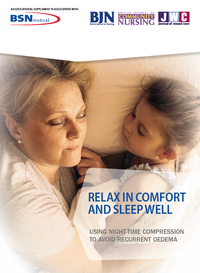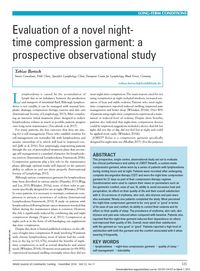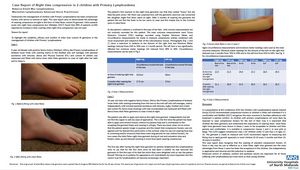Clinical Evidence
Lymphoedema management at night: views from patients across five countries
Justine C Whitaker, BJCN, Chronic Oedema, October 2016
This study provides an insight into the use of night-time compression in lymphoedema management looking at 94 patients from five countries who had been suffering from lymphoedema for more than 12 months. The study provides a better understanding of how night-time compression regimens are initiated, products used, benefits to patients and identified unmet needs.

Key Findings
- Patients describe worst aspects of night-time swelling as aching, pain, tight, uncomfortable and heavy
- Night swelling impacts patient’s lives, especially causing pain and sleep disturbance
- Two thirds of patients reported oedema to be worse or comparable to daytime
- All patients identified benefit from using night-time compression
- 80% of patients reported a reduction or management of oedema when wearing night-time compression
- 89% of patients reported an increase in swelling when night-time compression was not used
- Main reasons for not wearing night-time compression were fatigue, heat and stable oedema
- Patient feedback on addressing unmet need and on how to increase concordance identified a more comfortable product; less tight, that does not cut into skin, has no slippage, is more breathable, is less warm and easier to don
- Further studies proposed to understand lymphoedema processes during rest and at night
To read the full article click here.

Relax in comfort and sleep well – using night-time compression to avoid recurrent oedema
A case series
Abstract
Compression therapy has been used for centuries to treat disorders of the venous and lymphatic circulatory systems. As long as bandages have been used to manage lower limb problems, compression has been applied at night. Research shows that use of compression at night-time can reduce swelling, but that patients can be deterred from wearing it as they often find it too hot, uncomfortable and difficult to put on (Whitaker, 2016).
This article explores the benefits of including night-time compression into a self-management regimen with JOBST Relax and describes the development of a garment that is compatible with night-time usage.
Conclusion
This article highlights the evidence on the clinical benefits of night-time compression and the development of a garment specifically designed to facilitate this. The rest of this supplement comprises case studies describing nurses’ and patients’ clinical experiences of JOBST® Relax.
To read more about how this JOBST Relax might benefit you and your patients click here.

Evaluation of a novel night-time compression garment: a prospective observational study
Tobias Bertsch - Senior Consultant, Földi Clinic, Specialist Lymphology Clinic, European Centre for Lymphology
Abstract
This prospective, single-centre, observational study set out to evaluate the clinical performance and safety of JOBST Relax, a custom-made compression garment, when worn by a series of patients with lymphoedema during resting hours and at night.
Patients were recruited after undergoing complete decongestive therapy (CDT) and wore the night-time compression garment for 21 days as part of their compression therapy regimen. Questionnaires were used to capture their views on parameters such as the garment’s comfort, ease of use, fit, ability to avoid excessive heat and perspiration, its effect on their quality of life and their overall satisfaction with it.
91 patients completed the study. Most perceived the night-time compression garment to be ‘very good’ or ‘good’ in terms of its ease of use and comfort, its ability to control their oedema and its effect on their quality of sleep. Patients also reported that the night-time garment reduced their dependence on others and improved their quality of life.
To read more about how this JOBST Relax might benefit you and your patients click here.

Case report of night-time compression in two children with primary lymphoedema
Rebecca Elwell Msc Lymphoedema, Macmillan Lymphoedema Advanced Nurse Practitioner
Traditionally the management of children with primary lymphoedema has been compression hosiery with advice to remove at night. This case report aims to demonstrate the advantage of wearing compression at night in the form of the JOBST Relax custom-fit garment. Little research exists into night time compression but Whitaker (2016) found that 89% of patients (n=94) reported an increase in their swelling when night-time compression was not used.
This report aims to highlight the suitability, efficacy and comfort of JOBST Relax custom-fit garment in the management of children with primary lymphoedema.
To read more about how this JOBST Relax might benefit you and your patients click here.
If you would like to learn more about night-time compression, ask your Essity Account Manager or contact our Concierge team on TEL: 01482 670177 or email concierge.service@essity.com

